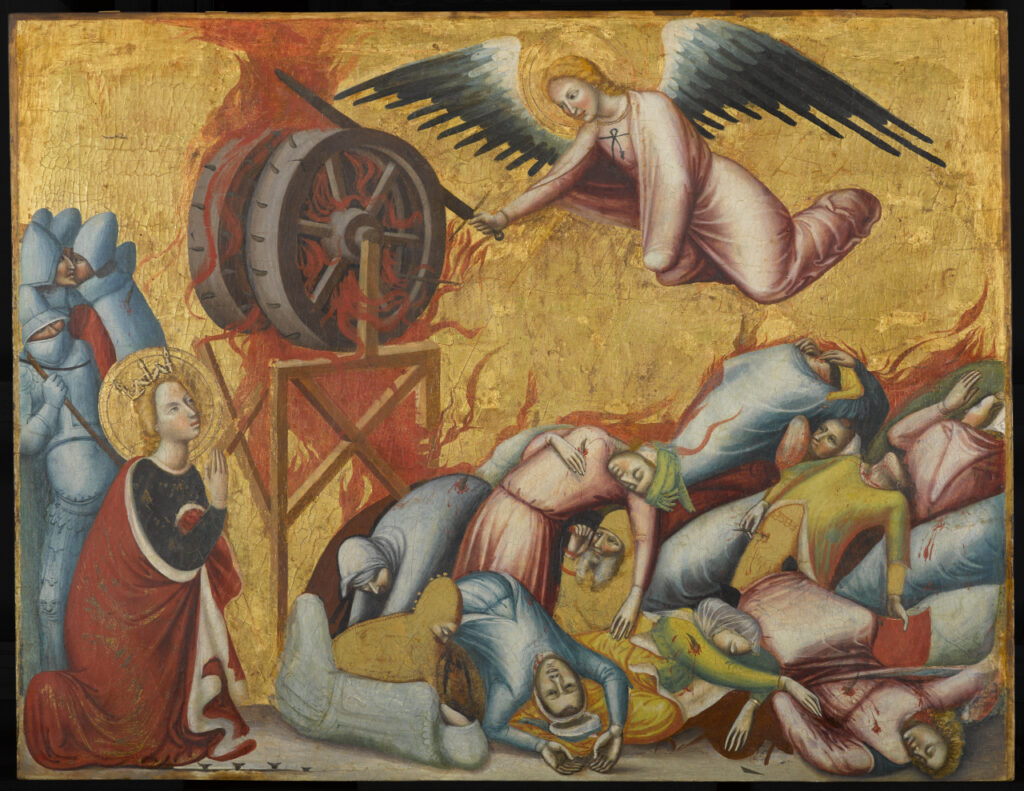Panel of an altarpiece dedicated to St. Catherine: St. Catherine Freed from the Wheel (work of art)
Artwork Info
Key Ideas
- This painting depicts an imagined scene of Saint Catherine being freed from the spiked wheel that was going to be used to execute her. When she touched the wheel, a miracle occurred. The wheel suddenly broke, and her death was postponed.
- Saint Catherine, also known as Catherine of Alexandria, is a saint in the Catholic Church. According to legend she was martyred (killed for her religious beliefs) around 305 in Alexandria, Egypt.
- In this painting Saint Catherine is depicted kneeling in prayer. She wears a golden crown and a red-and-white robe over a black dress.
- This work was originally part of an altarpiece. An altarpiece is a work of art that decorates the space above and behind the altar in a church.
- The flying angel in this painting is depicted wearing a light red-toned robe. The angel’s clothing was most likely painted using kermes dye.
- Kermes is a red dye that comes from an insect that feeds on the sap of oak trees.
Learn More
This painting was part of an altarpiece that decorated the space above and behind the altar in a church. It depicts an imagined scene of Saint Catherine being freed from the spiked wheel on which she was sentenced to be executed for her religious beliefs. According to the story of Saint Catherine, a miracle happened when she touched the wheel. It suddenly shattered, saving her her life (at least in that moment). The torture device depicted in this painting is called a breaking wheel. It is also known as the execution wheel, the Wheel of Catherine, or Saint Catherine’s Wheel. This wheel was used for public executions in Europe until the 19th century.
Catherine of Alexandria was, according to legend, a young woman who converted to Christianity after she had a vision. She debated 50 pagan philosophers and convinced them to become Christians, along with about 200 soldiers and members of the emperor’s family. All of them were martyred, or killed for their religious beliefs. Catherine was about 18 years old when she was sentenced to be executed on a spiked wheel. Although a miracle helped her escape torture and death on the execution wheel, the emperor Maxentius had her executed by beheading. It is said that angels later carried Catherine’s body to a monastery at the foot of Mount Sinai.
In the Catholic tradition, Saint Catherine of Alexandria was a fourth-century Alexandrian noblewoman, Christian, and scholar. She is the patron saint of philosophers, unmarried girls, and craftspeople who work with wheels (such as potters and spinners). She is also known as one of the Fourteen Holy Helpers. Saint Catherine’s Day, or the Feast of Saint Catherine, is celebrated around the world on November 25.
In this painting of Saint Catherine, the angel flying above the scene is depicted wearing a light red-toned robe. The angel’s clothing was most likely painted using kermes red. Kermes red is one of the oldest known organic dyes. It comes from an insect that feeds on the sap of Mediterranean oak trees. The dye is obtained from the crushed, dried bodies of the female kermes insect.
The name kermes comes from the Sanskrit word krmiza, which means worm-made. The color names carmine and crimson come from this root word. Kermes was also called grana (grain) because it was often mistaken as a plant seed or berry. Highly prized kermes-dyed fabrics like silk and wool were described as being “dyed in the grain.” This gave rise to the term “ingrained.”
Kermes is mentioned in the old and new testaments of the Bible. It is believed that the Hebrews obtained kermes from the Phoenicians and used it to dye the curtains of their tabernacle.
Additional Resources
Resources for Teachers
- Explore an educational resource that includes lessons featuring Saint Catherine of Alexandria.
- Read an article about Saint Catherine that describes how her feast day is celebrated around the world.
- Watch a video that includes information (near the end of the clip) about the red dye derived from the kermes insect.
Resources for Students
- Watch a short video about Saint Catherine of Alexandria.
- View images of other paintings that depict Saint Catherine of Alexandria.
- Read an article about kermes dye.

